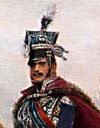 |
| Cover of the Autumn 2003 Arcadian Guild Quarterly |
The game featured on the cover was run in 15mm with Kelly Jones' collection, soon after he moved to Victoria.
 |
| summary of the re-fight of Salamanca from Autumn 2003 AGQ |
Today I was inspired to pull out my 15mm minis, that are all setup for doing a Napoleonic version of Hordes of the Things, and put together a re-creation of the battle for this scale - using my own homebrew DBN rules.
I have a set of 12"x12" boards that have pre-set terrain on them, I have also made up a set of map generators, with a parchment feel, for setting up campaign game battles - formerly via e-mail (I did a series of Waterloo campaigns with them that worked out quite well - more about that some other time).
 |
| a parchment version of the map used in today's refight of Salamanca |
The parchment blocks are not 'exact' copies of the boards, so the planning stages can have some unpredictability about them.
 |
| tabletop terrain and troops laid out 2' x 3' |
 |
| Artillery in a duel |
The counter-attack from the British and Portuguese cavalry was enough to eliminate all of the French cavalry ... half way to victory!
 |
| raging artillery duel continued while British cavalry cut up their French counterparts |
 |
| British and Portuguese cavalry fall back, having lost 1/3 of their forces, meanwhile the French cannot get any effective fire into their counter attacks |
Then a critical decision is made, the French commander moves into the line - preparing to make a push along with the left flank and at least take out one force of British foot. This would put the commander into artillery range for one salvo at least ...
The British artillery did not miss! Command was broken for one turn before devolving to the flag carrying infantry formation on the other side of the massed batteries. Score was now British 3 : French 1
 |
| new French command is temporarily disordered from artillery fire (spiral marker) |
New command took time to maneuver the line back into a battle ready action formation, meanwhile the British command rolls continued to be terrible. Keeping the British from doing much more than get ready for the next French attack.
The line re-formed and charged, this time it did not fail and one British line unit was routed.
The counter attack and artillery barrage put the final nail in the coffin for the French as they lost one more unit of infantry ... final score British 4 : French 2, the French were forced to retire from the field - just as historically happened 200 years ago.
 |
| with only 3rd battalions of infantry to cover the left flank the French were obliged to start withdrawl |
While searching for the old pictures of Salamanca, I came across this Larry Leadhead classic:
 |
| when was the last time you searched your 'lead mound'? |
There were other great items for campaign work and game action photos that I have also found ... giving me more food for thought and some great 'looking back' material for future posts here with MurdocK's MarauderS






















































4 comments:
What I like most about this account is that it shows you don't need thousands of figures to refight big battles.
And I can well understand Larry Leadhead's attaitude. I find these days I am very uncertain of what I have in my inventory; but sell any of it off...? No way, "Hozay"! How can one be so heartless? (I will swap stuff, though...).
Cheers,
Ion
Luckiliy the history has repeated itself...
Regards
Rafa
Yes Ion, I have been doing discovery of using less minis for 'representing' the big battalions. Or in the case of Fast Play Grand Armee, brigades.
I have sold off parts of my collection in the past, particularly when storage space suddenly became limited and I had to reduce, so out went the 1806 Prussians and all of the Austrians. Fortunately I can re-cast them in the future...
Rafa,
Yes the 'strung out' nature of the French at Los Arapiles makes it nearly impossible to recover, though most of the early French moves in my game yesterday were very conservative, pulling back from the British, getting the cavalry together on the flank, maneuvering my artillery to an effective position.
The problem is one of 'exterior' vs 'interior' lines of communication, the French are just too far spread out ... the British had a nice tight inner circle, this makes the British moves easier and the French ones take longer to complete.
Marmont was truly 'caught with his pants down' in this battle.
Looking very nice, I do like this battle! Great pictures.
Post a Comment